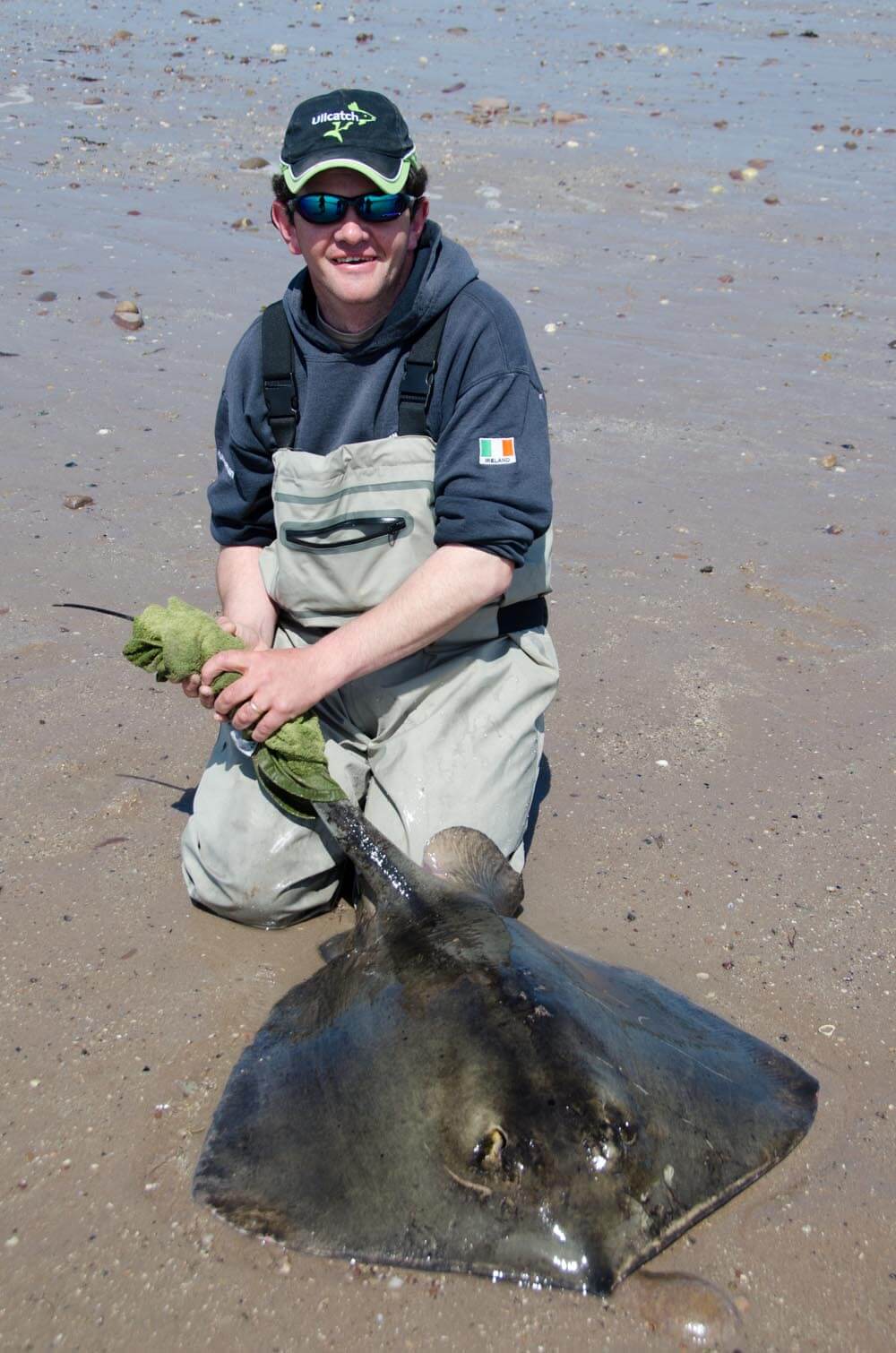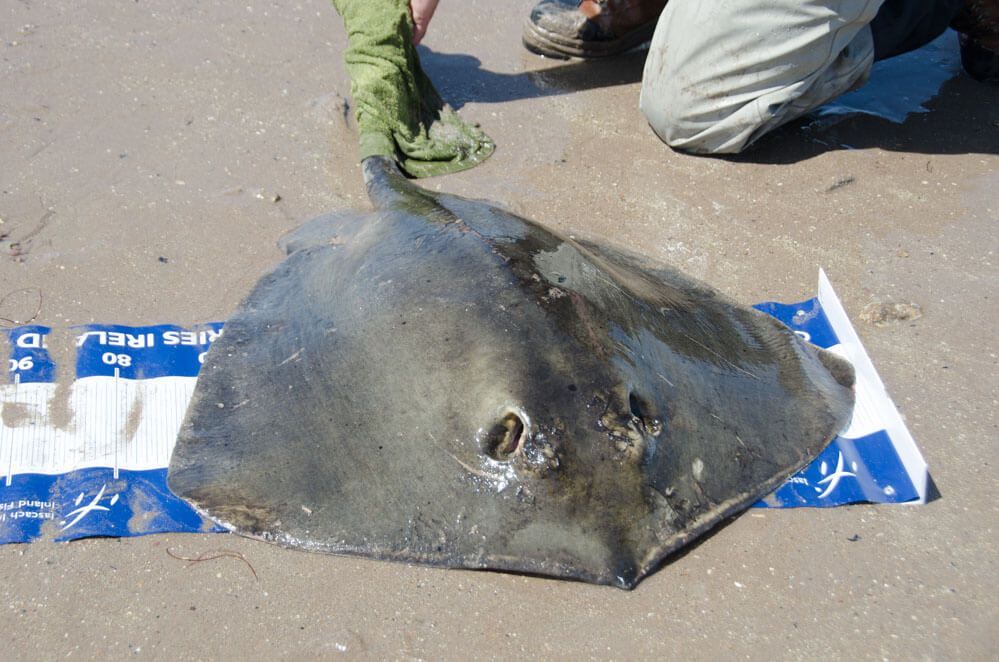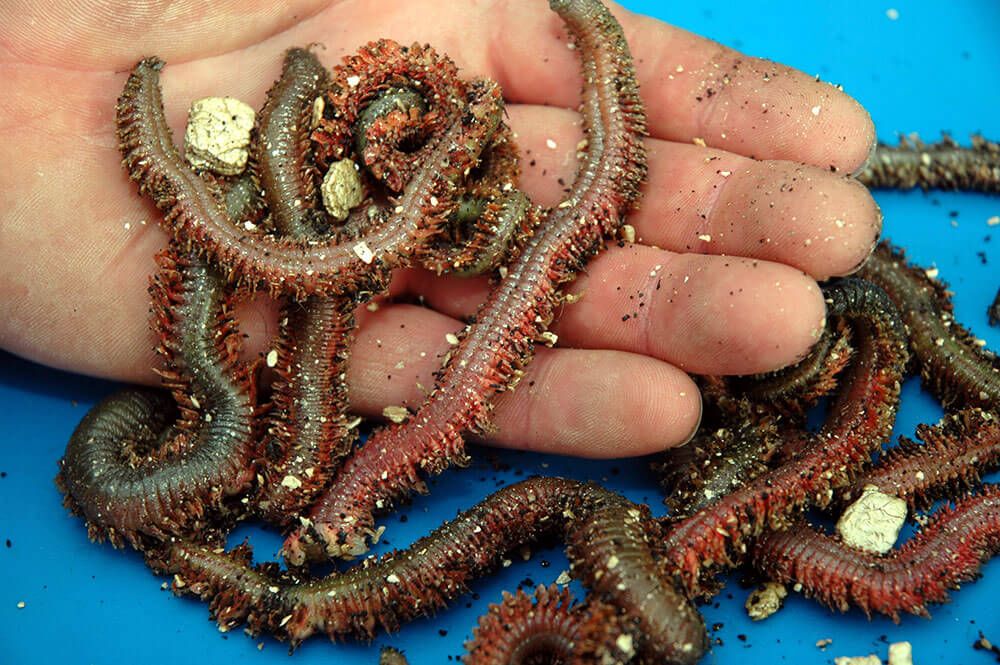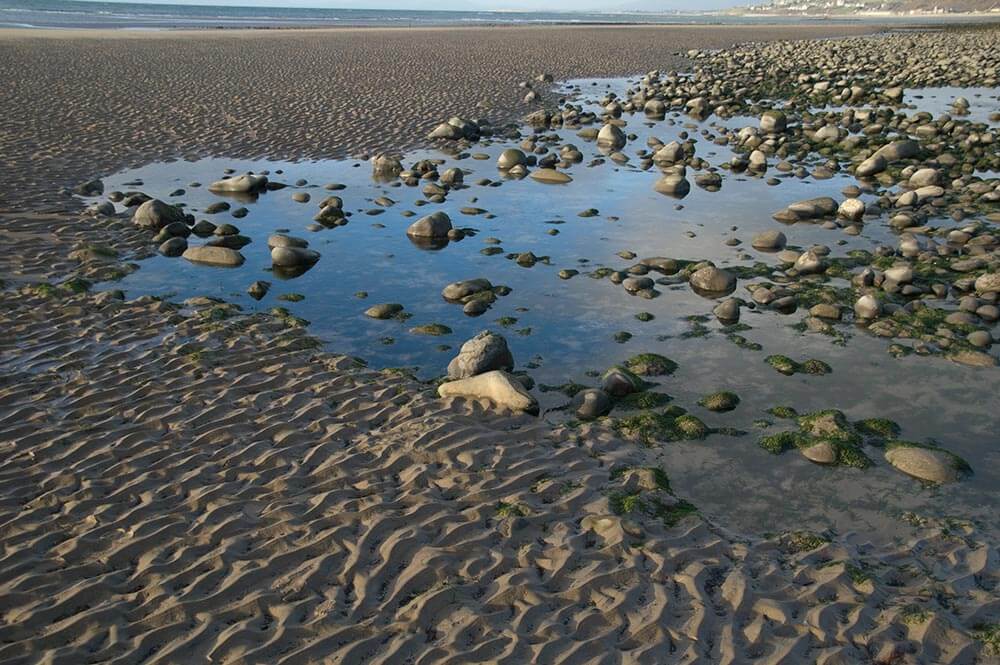Stingray are probably more common in UK waters than was once realised, though their numbers can fluctuate in what seems like five year periods quite dramatically. Some years there are fair numbers of mainly smaller fish, other years it’s predominantly a few big fish over 20lbs with less smaller ones.
Though their general shape is similar to other rays they are easy to identify. Simply look at the tail. This is long and whip like with no dorsal fin, but with one, two or even three distinctive serrated spines on the tail that give this ray its name. These individual stings can be up to 5-inches long and the tissue lining the grooves is laden with poison. The ray uses its tail, scorpion fashion, bringing it forwards over the body and if a person gets stabbed it can inflict a serious wound that will need immediate hospital attention.
Their colouration is typically slate grey or olive when living over mud, but brown when living over sand. Occasionally stingray will be caught with a mix of the back colour interfaced with lighter blotches which is an indication these fish have been living over a mixed mud/boulder seabed or shingle. The belly is cream with grey edges.
Female stingray give birth to live young, typically between 6 and 9 baby rays, though little is known of their breeding habits and the theory is that they breed south of the British Isles in warmer waters. The opposite theory is that they breed in British waters, but the females birth to the south which is the most likely. Their diet consists of mainly crabs, shellfish and worms.

Without doubt stingray larger than the current listed shore record have been caught by anglers in the past, but returned unharmed to the sea. There have been reports in the past of stingray estimated at 70lbs being released and this is not that extreme as these fish can and will exceed 100lbs in weight in UK waters, this confirmed by inshore commercial fishing captures.
WHEN AND WHERE TO FISH
Stingray inhabit waters from the North Sea and Ireland down the western European coast taking in the whole of the Mediterranean Sea, and also right down the African continent.
They are caught generally from a line drawn across the UK between the River Mersey and The Wash, but with the hotspots being the Essex coast, especially St Osyth, the Hampshire coast, The Bristol Channel especially the South Wales side, and Cardigan Bay in west Wales as far as Pwllheli which seems their general limit of northerly migration. In Ireland stingray show mainly from the Kerry coast, particularly Tralee Bay and the beaches adjacent to Castlegregory. That said any of the outer estuaries along the southern Irish coast can produce the odd stingray.
The season for stingray is typically late April on with late May and June the best period for numbers of fish. By July their numbers will be thinning out leaving only smaller rays tight inshore. This latter trend is typical in Kerry where small stingray up to 5 or 6lbs can still be caught in the surf in Dingle during August and September.
Stingray only seem to feed in daylight in clear coloured seas and especially when the flooding tide washes over sand warmed by a hot sun. In these conditions they run the surf often less than 50yds out and in surprisingly shallow water just a few feet deep. There’s a pattern in many areas where the best stinger conditions are a middle sized tide rising towards springs with low water in the early afternoon. The sun warms the sand and then as the flood tide comes in over the warm sand the fish seem to show during the middle period of the tide disappearing again just before high tide.

They do not like rough and coloured seas during and after storms. Calm, hot and humid conditions are the best with a gentle surf or no surf at all.
Stingray will hunt down the edges of estuaries along the divide line where mud and sand meets rock and weed looking for crab. They also choose deeper holes in outer estuary channels adjacent to mussel beds and deeper holes in the main estuary channel where mud gets deposited. On surf beaches they are often moving somewhere but will linger around weed beds, boulder accumulations and swim down the outer surf line looking for washed out food.
SHORE STINGRAY TACKLE
You never know what size the stingray you hook might be, so the best all round outfit is a fairly powerful 4-6oz beachcaster between 12ft 6ins and 13ft 6ins. Match this to a tough reel with a smooth drag such as the Penn 525Mag2 or the Shimano Torium. Load the reels with 20lb mono and finish with a 60lb shock leader.
In some areas, such as when fishing the Castlegregory beaches in Kerry, then a 3-4oz bass rod will be fine with a 6500 sized reel and just 15lb line.
HOW TO BUILD A SHORE STINGRAY RIG
BAITS FOR STINGRAY
Stingray are not overly fussy and can on occasions be caught on most common baits. However king ragworm would be the most consistent taker of fish in areas such as St Osyth and the marks along the Hampshire coast, followed closely by peeler and sometimes soft crab. In the Bristol Channel again rag is the top bait, but in Cardigan Bay they take crab almost exclusively when running the shoreline.
Again in Kerry the top bait is crab, with mackerel strip good for the smaller fish from August onwards when fishing the surf, though lugworm also picks up a few. Squid can also take stingers, especially the smaller party squid used two or three at a time to make a bait about the size of a big mussel.
Stingray hunt by smell, so when making baits make sure they ooze plenty of scent. Don’t use whole ragworm, break them up in to sections and put the various sections on to release juices. The same with crab, cut the crab in two then bend the pieces together to form a juicy bait that lets the scent flood out.

TOP TIP 1
When running the length of a surf beach, stingray tend to swim down the deepest edge of a parallel lying gully. This is where the food washed in by the tide falls and collects. Look to cast just out on to the flat upper area of the bank, then retrieve the bait gently until you fell it fall in to the gutter and leave it there. This is a prime spot!
TOP TIP 2
When fishing around the mouths of estuaries, look for shallow gullies lying tight to boulders and shingle. The stingray use these to swim in to the estuaries and pick up baits they find in front of them.

TOP TIP 3
Stingray are powerful fish and having taken a bait will swim off powerfully. When you strike and they feel the tension of the rod and line, they will run fast with the tide. When they feel the surf shallowing as you bring them in again they tend to make several fast runs up and down the surf line parallel with the beach. Make sure the drag on your reel is adjusted to give line well below the main line’s breaking strain.
TOP TIP 4
There is no need to gaff stingray. Smaller fish can be slid up the beach on a wave by pulling gently on the hook snood. Bigger fish should be held by the nose and slid ashore, but always watching for that tail sweeping over the back towards you. The fish can be returned to the water the same way after a photo or two.
TOP TIP 5
Big stingray will really test your tackle and this especially applies to the hook. A proven pattern is the Mustad 79515 Viking, though Sakuma Manta’s are also good. Size 3/0 to 4/0 have the size to take a decent bait, but also the strength in the wire to take the pressure applied by a fast running fish using its weight against the waves or tide.
Though their general shape is similar to other rays they are easy to identify. Simply look at the tail. This is long and whip like with no dorsal fin, but with one, two or even three distinctive serrated spines on the tail that give this ray its name. These individual stings can be up to 5-inches long and the tissue lining the grooves is laden with poison. The ray uses its tail, scorpion fashion, bringing it forwards over the body and if a person gets stabbed it can inflict a serious wound that will need immediate hospital attention.
Their colouration is typically slate grey or olive when living over mud, but brown when living over sand. Occasionally stingray will be caught with a mix of the back colour interfaced with lighter blotches which is an indication these fish have been living over a mixed mud/boulder seabed or shingle. The belly is cream with grey edges.
Female stingray give birth to live young, typically between 6 and 9 baby rays, though little is known of their breeding habits and the theory is that they breed south of the British Isles in warmer waters. The opposite theory is that they breed in British waters, but the females birth to the south which is the most likely. Their diet consists of mainly crabs, shellfish and worms.

Without doubt stingray larger than the current listed shore record have been caught by anglers in the past, but returned unharmed to the sea. There have been reports in the past of stingray estimated at 70lbs being released and this is not that extreme as these fish can and will exceed 100lbs in weight in UK waters, this confirmed by inshore commercial fishing captures.
WHEN AND WHERE TO FISH
Stingray inhabit waters from the North Sea and Ireland down the western European coast taking in the whole of the Mediterranean Sea, and also right down the African continent.
They are caught generally from a line drawn across the UK between the River Mersey and The Wash, but with the hotspots being the Essex coast, especially St Osyth, the Hampshire coast, The Bristol Channel especially the South Wales side, and Cardigan Bay in west Wales as far as Pwllheli which seems their general limit of northerly migration. In Ireland stingray show mainly from the Kerry coast, particularly Tralee Bay and the beaches adjacent to Castlegregory. That said any of the outer estuaries along the southern Irish coast can produce the odd stingray.
The season for stingray is typically late April on with late May and June the best period for numbers of fish. By July their numbers will be thinning out leaving only smaller rays tight inshore. This latter trend is typical in Kerry where small stingray up to 5 or 6lbs can still be caught in the surf in Dingle during August and September.
Stingray only seem to feed in daylight in clear coloured seas and especially when the flooding tide washes over sand warmed by a hot sun. In these conditions they run the surf often less than 50yds out and in surprisingly shallow water just a few feet deep. There’s a pattern in many areas where the best stinger conditions are a middle sized tide rising towards springs with low water in the early afternoon. The sun warms the sand and then as the flood tide comes in over the warm sand the fish seem to show during the middle period of the tide disappearing again just before high tide.

They do not like rough and coloured seas during and after storms. Calm, hot and humid conditions are the best with a gentle surf or no surf at all.
Stingray will hunt down the edges of estuaries along the divide line where mud and sand meets rock and weed looking for crab. They also choose deeper holes in outer estuary channels adjacent to mussel beds and deeper holes in the main estuary channel where mud gets deposited. On surf beaches they are often moving somewhere but will linger around weed beds, boulder accumulations and swim down the outer surf line looking for washed out food.
SHORE STINGRAY TACKLE
You never know what size the stingray you hook might be, so the best all round outfit is a fairly powerful 4-6oz beachcaster between 12ft 6ins and 13ft 6ins. Match this to a tough reel with a smooth drag such as the Penn 525Mag2 or the Shimano Torium. Load the reels with 20lb mono and finish with a 60lb shock leader.
In some areas, such as when fishing the Castlegregory beaches in Kerry, then a 3-4oz bass rod will be fine with a 6500 sized reel and just 15lb line.
HOW TO BUILD A SHORE STINGRAY RIG
BAITS FOR STINGRAY
Stingray are not overly fussy and can on occasions be caught on most common baits. However king ragworm would be the most consistent taker of fish in areas such as St Osyth and the marks along the Hampshire coast, followed closely by peeler and sometimes soft crab. In the Bristol Channel again rag is the top bait, but in Cardigan Bay they take crab almost exclusively when running the shoreline.
Again in Kerry the top bait is crab, with mackerel strip good for the smaller fish from August onwards when fishing the surf, though lugworm also picks up a few. Squid can also take stingers, especially the smaller party squid used two or three at a time to make a bait about the size of a big mussel.
Stingray hunt by smell, so when making baits make sure they ooze plenty of scent. Don’t use whole ragworm, break them up in to sections and put the various sections on to release juices. The same with crab, cut the crab in two then bend the pieces together to form a juicy bait that lets the scent flood out.

TOP TIP 1
When running the length of a surf beach, stingray tend to swim down the deepest edge of a parallel lying gully. This is where the food washed in by the tide falls and collects. Look to cast just out on to the flat upper area of the bank, then retrieve the bait gently until you fell it fall in to the gutter and leave it there. This is a prime spot!
TOP TIP 2
When fishing around the mouths of estuaries, look for shallow gullies lying tight to boulders and shingle. The stingray use these to swim in to the estuaries and pick up baits they find in front of them.

TOP TIP 3
Stingray are powerful fish and having taken a bait will swim off powerfully. When you strike and they feel the tension of the rod and line, they will run fast with the tide. When they feel the surf shallowing as you bring them in again they tend to make several fast runs up and down the surf line parallel with the beach. Make sure the drag on your reel is adjusted to give line well below the main line’s breaking strain.
TOP TIP 4
There is no need to gaff stingray. Smaller fish can be slid up the beach on a wave by pulling gently on the hook snood. Bigger fish should be held by the nose and slid ashore, but always watching for that tail sweeping over the back towards you. The fish can be returned to the water the same way after a photo or two.
TOP TIP 5
Big stingray will really test your tackle and this especially applies to the hook. A proven pattern is the Mustad 79515 Viking, though Sakuma Manta’s are also good. Size 3/0 to 4/0 have the size to take a decent bait, but also the strength in the wire to take the pressure applied by a fast running fish using its weight against the waves or tide.

